Unit 7 Have you ever been to a museum? Section A (1a-2d)基础必会清单及知识闯关
文档属性
| 名称 | Unit 7 Have you ever been to a museum? Section A (1a-2d)基础必会清单及知识闯关 | 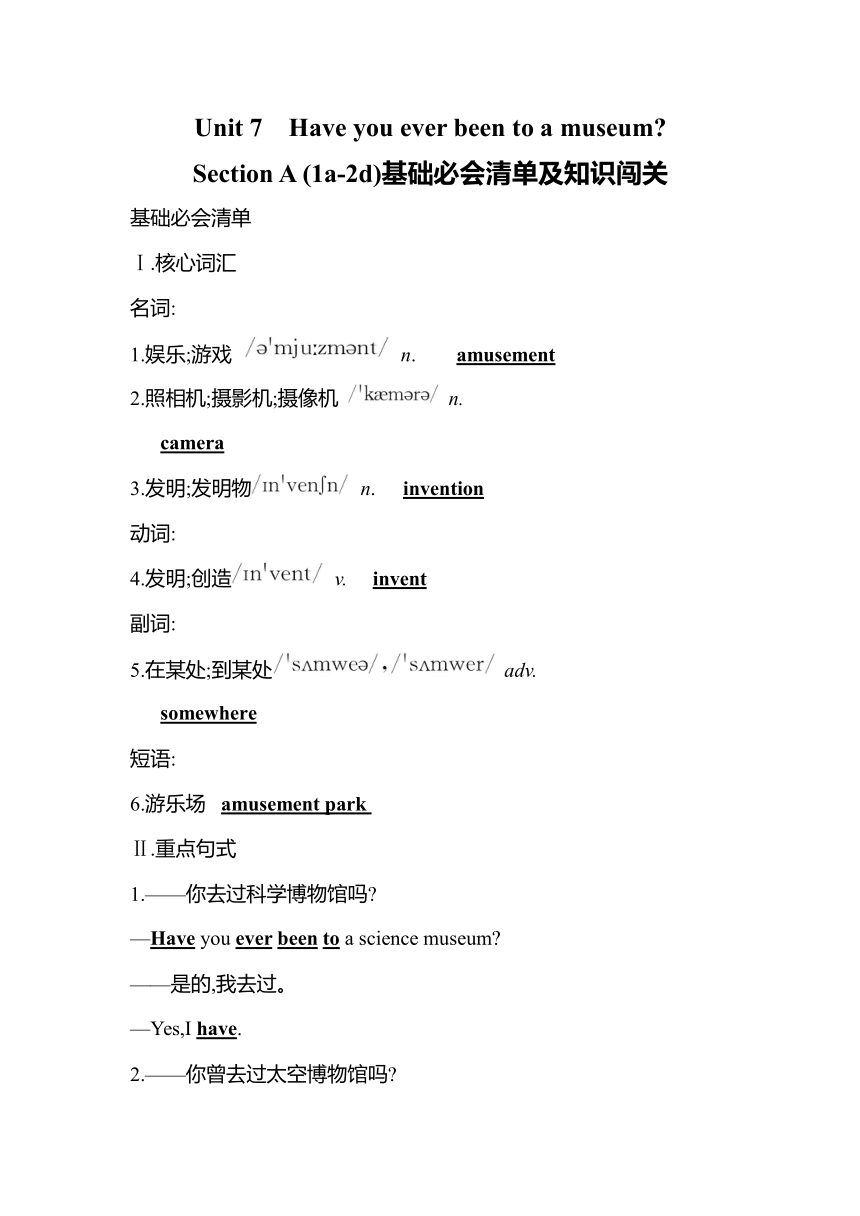 | |
| 格式 | docx | ||
| 文件大小 | 99.6KB | ||
| 资源类型 | 教案 | ||
| 版本资源 | 鲁教版 | ||
| 科目 | 英语 | ||
| 更新时间 | 2024-02-07 11:14:19 | ||
图片预览

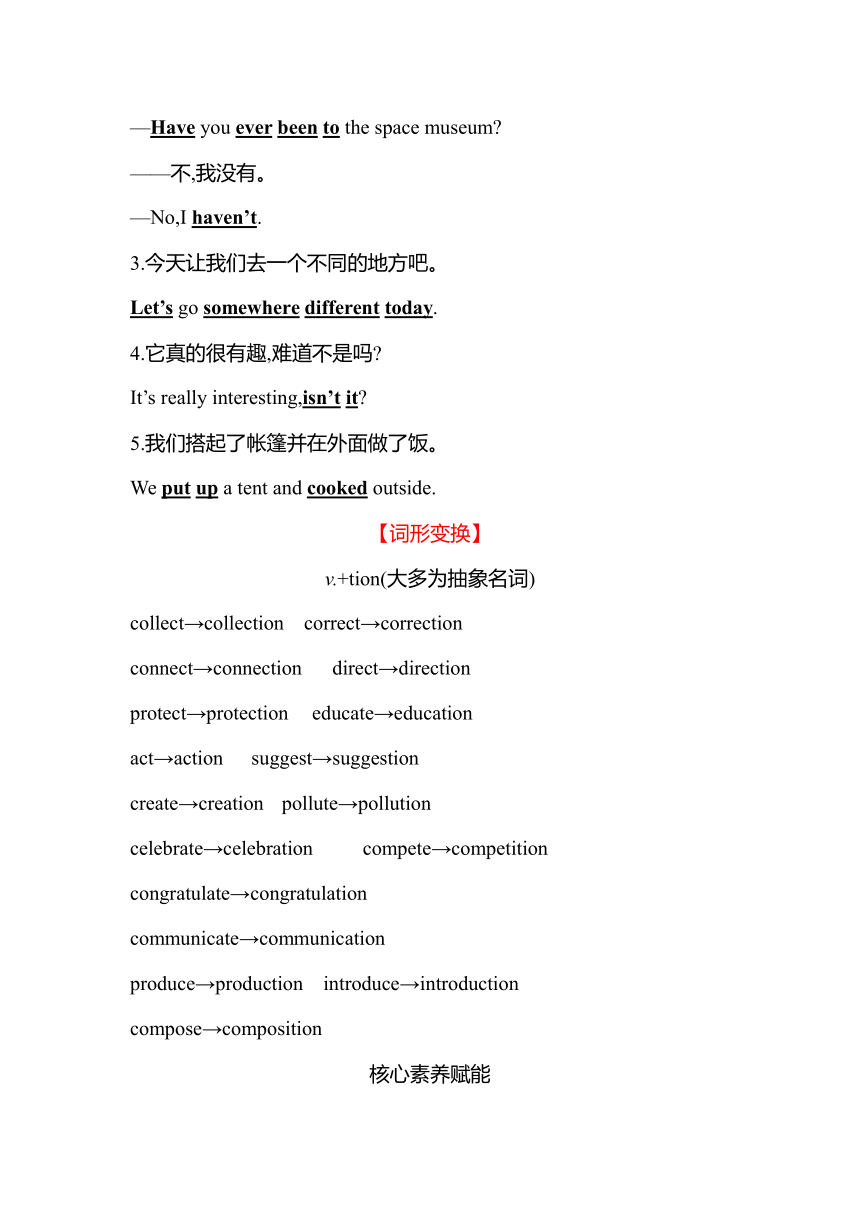
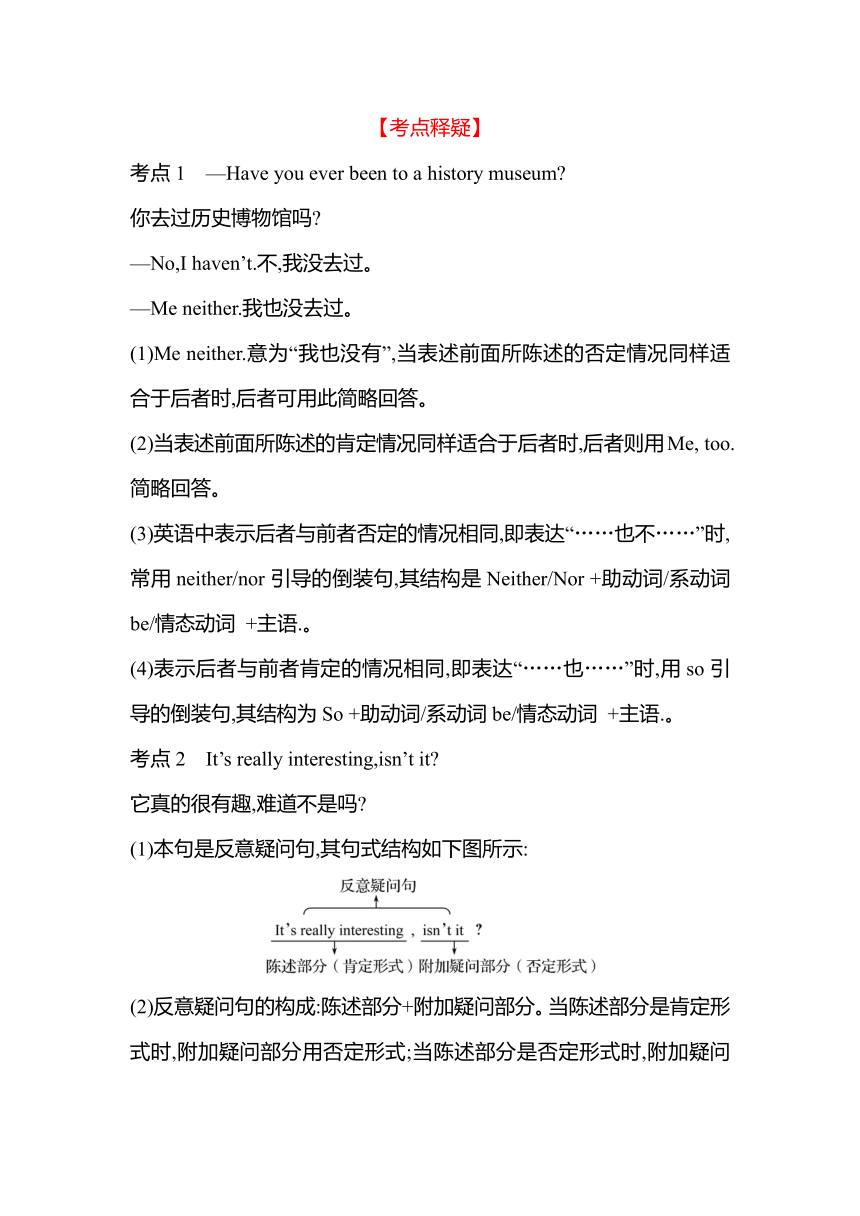
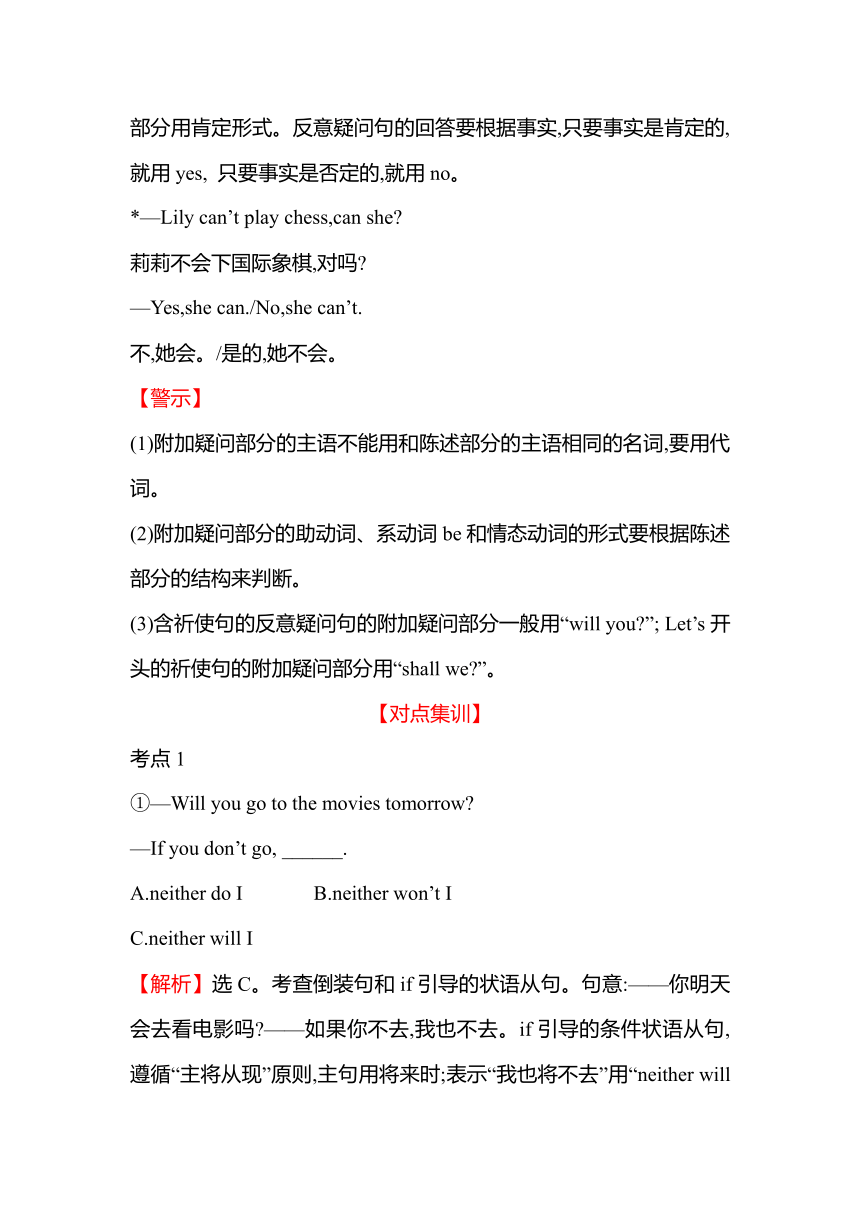
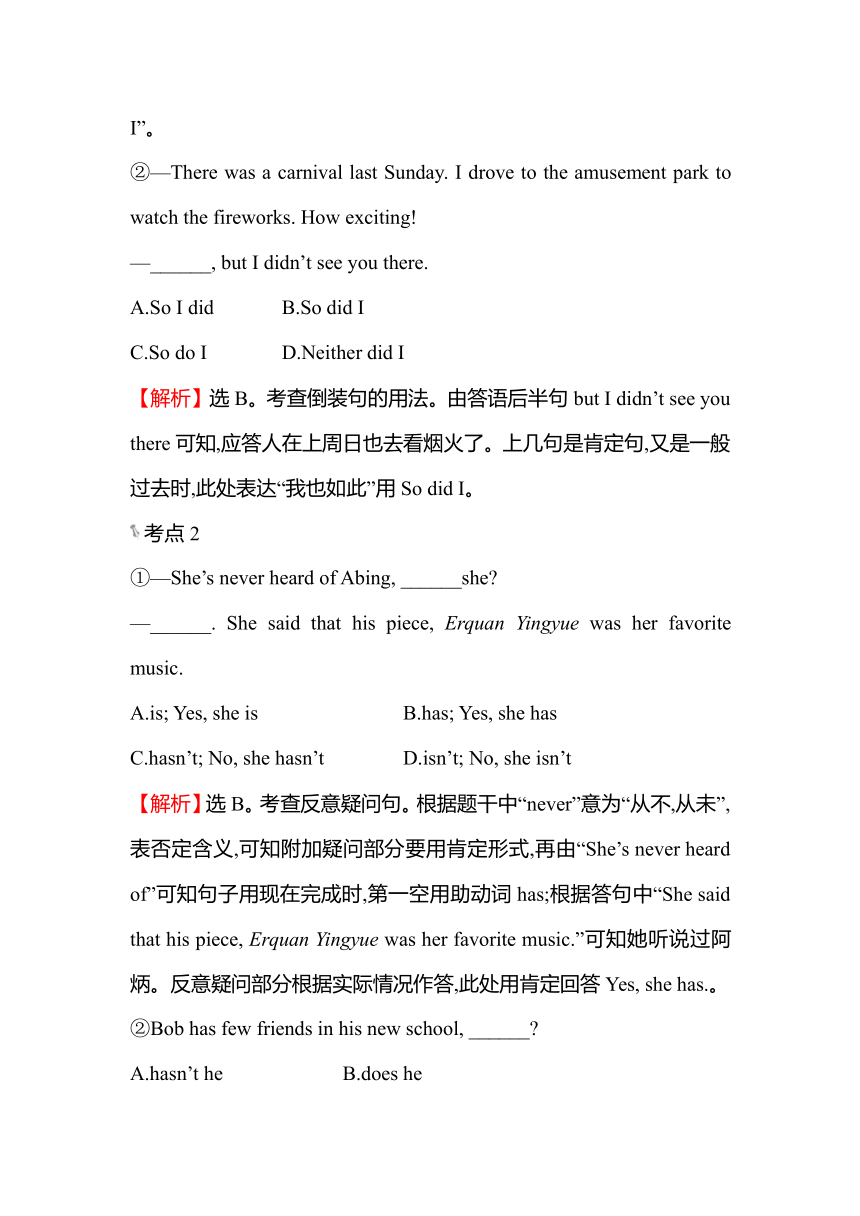
文档简介
Unit 7 Have you ever been to a museum
Section A (1a-2d)基础必会清单及知识闯关
基础必会清单
Ⅰ.核心词汇
名词:
1.娱乐;游戏 n. amusement
2.照相机;摄影机;摄像机 n.
camera
3.发明;发明物 n. invention
动词:
4.发明;创造 v. invent
副词:
5.在某处;到某处 adv.
somewhere
短语:
6.游乐场 amusement park
Ⅱ.重点句式
1.——你去过科学博物馆吗
—Have you ever been to a science museum
——是的,我去过。
—Yes,I have.
2.——你曾去过太空博物馆吗
—Have you ever been to the space museum
——不,我没有。
—No,I haven’t.
3.今天让我们去一个不同的地方吧。
Let’s go somewhere different today.
4.它真的很有趣,难道不是吗
It’s really interesting,isn’t it
5.我们搭起了帐篷并在外面做了饭。
We put up a tent and cooked outside.
【词形变换】
v.+tion(大多为抽象名词)
collect→collection correct→correction
connect→connection direct→direction
protect→protection educate→education
act→action suggest→suggestion
create→creation pollute→pollution
celebrate→celebration compete→competition
congratulate→congratulation
communicate→communication
produce→production introduce→introduction
compose→composition
核心素养赋能
【考点释疑】
考点1 —Have you ever been to a history museum
你去过历史博物馆吗
—No,I haven’t.不,我没去过。
—Me neither.我也没去过。
(1)Me neither.意为“我也没有”,当表述前面所陈述的否定情况同样适合于后者时,后者可用此简略回答。
(2)当表述前面所陈述的肯定情况同样适合于后者时,后者则用Me, too.简略回答。
(3)英语中表示后者与前者否定的情况相同,即表达“……也不……”时,常用neither/nor引导的倒装句,其结构是Neither/Nor +助动词/系动词be/情态动词 +主语.。
(4)表示后者与前者肯定的情况相同,即表达“……也……”时,用so引导的倒装句,其结构为So +助动词/系动词be/情态动词 +主语.。
考点2 It’s really interesting,isn’t it
它真的很有趣,难道不是吗
(1)本句是反意疑问句,其句式结构如下图所示:
(2)反意疑问句的构成:陈述部分+附加疑问部分。当陈述部分是肯定形式时,附加疑问部分用否定形式;当陈述部分是否定形式时,附加疑问部分用肯定形式。反意疑问句的回答要根据事实,只要事实是肯定的,就用yes, 只要事实是否定的,就用no。
*—Lily can’t play chess,can she
莉莉不会下国际象棋,对吗
—Yes,she can./No,she can’t.
不,她会。/是的,她不会。
【警示】
(1)附加疑问部分的主语不能用和陈述部分的主语相同的名词,要用代词。
(2)附加疑问部分的助动词、系动词be和情态动词的形式要根据陈述部分的结构来判断。
(3)含祈使句的反意疑问句的附加疑问部分一般用“will you ”; Let’s开头的祈使句的附加疑问部分用“shall we ”。
【对点集训】
考点1
①—Will you go to the movies tomorrow
—If you don’t go, ______.
A.neither do I B.neither won’t I
C.neither will I
【解析】选C。考查倒装句和if引导的状语从句。句意:——你明天会去看电影吗 ——如果你不去,我也不去。if引导的条件状语从句,遵循“主将从现”原则,主句用将来时;表示“我也将不去”用“neither will I”。
②—There was a carnival last Sunday. I drove to the amusement park to watch the fireworks. How exciting!
—______, but I didn’t see you there.
A.So I did B.So did I
C.So do I D.Neither did I
【解析】选B。考查倒装句的用法。由答语后半句but I didn’t see you there可知,应答人在上周日也去看烟火了。上几句是肯定句,又是一般过去时,此处表达“我也如此”用So did I。
考点2
①—She’s never heard of Abing, ______she
—______. She said that his piece, Erquan Yingyue was her favorite music.
A.is; Yes, she is B.has; Yes, she has
C.hasn’t; No, she hasn’t D.isn’t; No, she isn’t
【解析】选B。考查反意疑问句。根据题干中“never”意为“从不,从未”,表否定含义,可知附加疑问部分要用肯定形式,再由“She’s never heard of”可知句子用现在完成时,第一空用助动词has;根据答句中“She said that his piece, Erquan Yingyue was her favorite music.”可知她听说过阿炳。反意疑问部分根据实际情况作答,此处用肯定回答Yes, she has.。
②Bob has few friends in his new school, ______
A.hasn’t he B.does he
C.doesn’t he
【解析】选B。考查反意疑问句。前面含有否定含义词few,附加疑问部分用肯定形式。
③David can hardly speak Chinese. (改为反意疑问句)
David can hardly speak Chinese, can he
【备选考点】
考点1 lead to通往;导致
lead意为“带路,领路;指引”,过去式和过去分词均为led,常用短语为:
(1)lead the way带路;
(2)lead to导致,通向;
(3)lead sb. to do sth.引领某人做某事。
*The street leads you to the station.
沿着这条街道走你就可以到达车站。
*He led us to travel around the city.
他带领我们游览了这座城市。
*All roads lead to Rome.条条大路通罗马。
【对点集训】
①这条路通往我的学校。
The road ___________________my school.
②你能带领我去公交车站吗
Can you __________me __________the bus station
答案:①leads to ②lead;to
考点2 somewhere adv.在某处;到某处
somewhere是不定副词,常用于肯定句中,由形容词修饰时,形容词要放于somewhere的后面。
*I want to go somewhere relaxing on vacation.
我想去令人放松的地方度假。
【拓展】其他的不定副词的用法
anywhere “某处;任何地方”,常用于否定句和疑问句中; 表示“任何地方”时,相当于everywhere 形容词修饰不定副词,应后置
everywhere “到处;处处”,相当于here and there
nowhere “没有地方”,表示否定的意义
*I can’t find my tennis bat anywhere.
我到处都找不到我的网球拍。
*His things are everywhere,so his room is untidy.
他的东西到处都是,因此他的房间不整洁。
*He found nowhere to live.
他找不到地方住了。
【对点集训】
①—Did you go ________last summer holiday
—Yes. I went to Shanghai Disney Resort.
A.somewhere special
B.anywhere special
C.special somewhere
D.special anywhere
【解析】选B。考查不定副词。somewhere一般用于肯定句;anywhere一般用于疑问句和否定句。修饰词一般放在不定副词的后面。
②这里太冷了。咱们去别的地方吧。
It’s too cold here.Let’s go ___________________.
③上个星期天你去什么有趣的地方了吗
Did you go ___________________last Sunday
答案:②somewhere else ③anywhere interesting
知能闯关
【基础关】
Ⅰ.用方框中所给单词的适当形式填空
amusement,subway,camera,invent,somewhere
1.He likes taking photos,so he always takes a(n)camera.
2.I went to a(n) amusement park with my best friend.
3.Let’s find somewhere quiet to have a rest.
4.Taking the subway is the fastest way to get to the water park.
5.I think the Internet is a very great invention.
Ⅱ.用所给词的适当形式填空
1.Neither of them has(have)lots of books.
2.They went(go)to the Water World a week ago.
3.I have finished(finish) my homework already.
4.It’s really(real) interesting to camp in the mountains.
5.Look! Frank and his friends are going skating(skate).
Ⅲ.完成句子
1.他曾经去过广州吗
Has he ever been to Guangzhou
2.我从没听到过那么恐怖的故事。
I have never heard of such a scary story.
3.他已经去过北京三次了。
He has been to Beijing three times.
4.大声朗读是一种学习英语的好方法。
Reading aloud is a good/great way to learn English.
5.昨天他没有去那里。我也没去。
He didn’t go there yesterday. Me neither.
【能力关】
Ⅳ.阅读理解
Shanghai is in East China.It’s an international city.Shanghai is famous for its night views and shopping centers.It is one of the largest cities in the world.It is also known as the “Shopping Paradise(天堂)” because there are a lot of department stores and huge shopping centers.Therefore,it’s not surprising that many tourists come to visit Shanghai every year for shopping.
People’s Square is known as the center of Shanghai.If you go there,you will see a huge open area with green grass,fountains(喷泉)and pigeons(鸽子).There are many new buildings around.You will find Shanghai Grand Theater,the Musical Hall and Shanghai Museum there.
If you go to Pudong New District in the east of Shanghai,you will see the Nanpu Bridge.It’s 8,364 meters long.It’s one of the longest suspension(悬浮) bridges in the world.In Pudong,you will also see the famous Oriental Pearl TV Tower.
1.Shanghai is in______.
A.South China B.East China
C.North China D.West China
【解析】选B。细节理解题。根据文章第一段第一句“Shanghai is in East China.”可知答案选B。
2.Shanghai is famous for its ______.
A.night views
B.shopping centers
C.clean air
D.A and B
【解析】选D。细节理解题。根据文章第一段第三句“Shanghai is famous for its night views and shopping centers.”可知答案选D。
3.______is known as the center of Shanghai.
A.Pudong New District
B.Shanghai Grand Theater
C.People’s Square
D.Oriental Pearl TV Tower
【解析】选C。细节理解题。根据文章第二段第一句“People’s Square is known as the center of Shanghai.”可知答案选C。
4.We can see ______at People’s Square.
A.green grass B.fountains
C.pigeons D.A,B and C
【解析】选D。细节理解题。根据文章第二段第二句“If you go there,you will see a huge open area with green grass,fountains and pigeons.”可知答案选D。
5.Shanghai is______ in the world.
A.the largest city
B.one of the largest cities
C.the smallest city
D.the most crowded city
【解析】选B。细节理解题。根据文章第一段“It is one of the largest cities in the world.”可知答案选B。
Ⅴ.语法填空
阅读下面短文,在空白处填入1个适当的单词或括号内单词的正确形式。
My love of making things began when I was a kid.I really became excited about inventing 1.after I learned about Thomas Edison.
One day in the fourth grade,our teacher gave us a project(项目)in class.We had to write to a company and learn about the products.I thought and thought.2.Finally(final), I chose the Thomas A.Edison Company.Soon after,the company sent me a book
about the life of Thomas Edison.How I enjoyed reading and rereading about his 3.inventions(invent)! I like the recorded sound and the electric light most.The inventions appeared 4.clearly(clear)in my brain.
My dad noticed my interest in inventing and 5.encouraged(encourage) me.He showed me how 6.to turn(turn)my ideas into plans and then into new things.Once,I surprised my dad 7.with a model plane I made.Later,we found a similar model plane in a store.I learned that different inventors often invent similar things.It is not 8.unusual(usual) for this to happen.I also learned that not all great ideas work.Failure is a common part of the inventing.
As my father and I worked together,I began to realize that my dad was quite an inventor 9.himself(him).He was always looking for a better way to do a 10.simple(simply) job.
Section A (1a-2d)基础必会清单及知识闯关
基础必会清单
Ⅰ.核心词汇
名词:
1.娱乐;游戏 n. amusement
2.照相机;摄影机;摄像机 n.
camera
3.发明;发明物 n. invention
动词:
4.发明;创造 v. invent
副词:
5.在某处;到某处 adv.
somewhere
短语:
6.游乐场 amusement park
Ⅱ.重点句式
1.——你去过科学博物馆吗
—Have you ever been to a science museum
——是的,我去过。
—Yes,I have.
2.——你曾去过太空博物馆吗
—Have you ever been to the space museum
——不,我没有。
—No,I haven’t.
3.今天让我们去一个不同的地方吧。
Let’s go somewhere different today.
4.它真的很有趣,难道不是吗
It’s really interesting,isn’t it
5.我们搭起了帐篷并在外面做了饭。
We put up a tent and cooked outside.
【词形变换】
v.+tion(大多为抽象名词)
collect→collection correct→correction
connect→connection direct→direction
protect→protection educate→education
act→action suggest→suggestion
create→creation pollute→pollution
celebrate→celebration compete→competition
congratulate→congratulation
communicate→communication
produce→production introduce→introduction
compose→composition
核心素养赋能
【考点释疑】
考点1 —Have you ever been to a history museum
你去过历史博物馆吗
—No,I haven’t.不,我没去过。
—Me neither.我也没去过。
(1)Me neither.意为“我也没有”,当表述前面所陈述的否定情况同样适合于后者时,后者可用此简略回答。
(2)当表述前面所陈述的肯定情况同样适合于后者时,后者则用Me, too.简略回答。
(3)英语中表示后者与前者否定的情况相同,即表达“……也不……”时,常用neither/nor引导的倒装句,其结构是Neither/Nor +助动词/系动词be/情态动词 +主语.。
(4)表示后者与前者肯定的情况相同,即表达“……也……”时,用so引导的倒装句,其结构为So +助动词/系动词be/情态动词 +主语.。
考点2 It’s really interesting,isn’t it
它真的很有趣,难道不是吗
(1)本句是反意疑问句,其句式结构如下图所示:
(2)反意疑问句的构成:陈述部分+附加疑问部分。当陈述部分是肯定形式时,附加疑问部分用否定形式;当陈述部分是否定形式时,附加疑问部分用肯定形式。反意疑问句的回答要根据事实,只要事实是肯定的,就用yes, 只要事实是否定的,就用no。
*—Lily can’t play chess,can she
莉莉不会下国际象棋,对吗
—Yes,she can./No,she can’t.
不,她会。/是的,她不会。
【警示】
(1)附加疑问部分的主语不能用和陈述部分的主语相同的名词,要用代词。
(2)附加疑问部分的助动词、系动词be和情态动词的形式要根据陈述部分的结构来判断。
(3)含祈使句的反意疑问句的附加疑问部分一般用“will you ”; Let’s开头的祈使句的附加疑问部分用“shall we ”。
【对点集训】
考点1
①—Will you go to the movies tomorrow
—If you don’t go, ______.
A.neither do I B.neither won’t I
C.neither will I
【解析】选C。考查倒装句和if引导的状语从句。句意:——你明天会去看电影吗 ——如果你不去,我也不去。if引导的条件状语从句,遵循“主将从现”原则,主句用将来时;表示“我也将不去”用“neither will I”。
②—There was a carnival last Sunday. I drove to the amusement park to watch the fireworks. How exciting!
—______, but I didn’t see you there.
A.So I did B.So did I
C.So do I D.Neither did I
【解析】选B。考查倒装句的用法。由答语后半句but I didn’t see you there可知,应答人在上周日也去看烟火了。上几句是肯定句,又是一般过去时,此处表达“我也如此”用So did I。
考点2
①—She’s never heard of Abing, ______she
—______. She said that his piece, Erquan Yingyue was her favorite music.
A.is; Yes, she is B.has; Yes, she has
C.hasn’t; No, she hasn’t D.isn’t; No, she isn’t
【解析】选B。考查反意疑问句。根据题干中“never”意为“从不,从未”,表否定含义,可知附加疑问部分要用肯定形式,再由“She’s never heard of”可知句子用现在完成时,第一空用助动词has;根据答句中“She said that his piece, Erquan Yingyue was her favorite music.”可知她听说过阿炳。反意疑问部分根据实际情况作答,此处用肯定回答Yes, she has.。
②Bob has few friends in his new school, ______
A.hasn’t he B.does he
C.doesn’t he
【解析】选B。考查反意疑问句。前面含有否定含义词few,附加疑问部分用肯定形式。
③David can hardly speak Chinese. (改为反意疑问句)
David can hardly speak Chinese, can he
【备选考点】
考点1 lead to通往;导致
lead意为“带路,领路;指引”,过去式和过去分词均为led,常用短语为:
(1)lead the way带路;
(2)lead to导致,通向;
(3)lead sb. to do sth.引领某人做某事。
*The street leads you to the station.
沿着这条街道走你就可以到达车站。
*He led us to travel around the city.
他带领我们游览了这座城市。
*All roads lead to Rome.条条大路通罗马。
【对点集训】
①这条路通往我的学校。
The road ___________________my school.
②你能带领我去公交车站吗
Can you __________me __________the bus station
答案:①leads to ②lead;to
考点2 somewhere adv.在某处;到某处
somewhere是不定副词,常用于肯定句中,由形容词修饰时,形容词要放于somewhere的后面。
*I want to go somewhere relaxing on vacation.
我想去令人放松的地方度假。
【拓展】其他的不定副词的用法
anywhere “某处;任何地方”,常用于否定句和疑问句中; 表示“任何地方”时,相当于everywhere 形容词修饰不定副词,应后置
everywhere “到处;处处”,相当于here and there
nowhere “没有地方”,表示否定的意义
*I can’t find my tennis bat anywhere.
我到处都找不到我的网球拍。
*His things are everywhere,so his room is untidy.
他的东西到处都是,因此他的房间不整洁。
*He found nowhere to live.
他找不到地方住了。
【对点集训】
①—Did you go ________last summer holiday
—Yes. I went to Shanghai Disney Resort.
A.somewhere special
B.anywhere special
C.special somewhere
D.special anywhere
【解析】选B。考查不定副词。somewhere一般用于肯定句;anywhere一般用于疑问句和否定句。修饰词一般放在不定副词的后面。
②这里太冷了。咱们去别的地方吧。
It’s too cold here.Let’s go ___________________.
③上个星期天你去什么有趣的地方了吗
Did you go ___________________last Sunday
答案:②somewhere else ③anywhere interesting
知能闯关
【基础关】
Ⅰ.用方框中所给单词的适当形式填空
amusement,subway,camera,invent,somewhere
1.He likes taking photos,so he always takes a(n)camera.
2.I went to a(n) amusement park with my best friend.
3.Let’s find somewhere quiet to have a rest.
4.Taking the subway is the fastest way to get to the water park.
5.I think the Internet is a very great invention.
Ⅱ.用所给词的适当形式填空
1.Neither of them has(have)lots of books.
2.They went(go)to the Water World a week ago.
3.I have finished(finish) my homework already.
4.It’s really(real) interesting to camp in the mountains.
5.Look! Frank and his friends are going skating(skate).
Ⅲ.完成句子
1.他曾经去过广州吗
Has he ever been to Guangzhou
2.我从没听到过那么恐怖的故事。
I have never heard of such a scary story.
3.他已经去过北京三次了。
He has been to Beijing three times.
4.大声朗读是一种学习英语的好方法。
Reading aloud is a good/great way to learn English.
5.昨天他没有去那里。我也没去。
He didn’t go there yesterday. Me neither.
【能力关】
Ⅳ.阅读理解
Shanghai is in East China.It’s an international city.Shanghai is famous for its night views and shopping centers.It is one of the largest cities in the world.It is also known as the “Shopping Paradise(天堂)” because there are a lot of department stores and huge shopping centers.Therefore,it’s not surprising that many tourists come to visit Shanghai every year for shopping.
People’s Square is known as the center of Shanghai.If you go there,you will see a huge open area with green grass,fountains(喷泉)and pigeons(鸽子).There are many new buildings around.You will find Shanghai Grand Theater,the Musical Hall and Shanghai Museum there.
If you go to Pudong New District in the east of Shanghai,you will see the Nanpu Bridge.It’s 8,364 meters long.It’s one of the longest suspension(悬浮) bridges in the world.In Pudong,you will also see the famous Oriental Pearl TV Tower.
1.Shanghai is in______.
A.South China B.East China
C.North China D.West China
【解析】选B。细节理解题。根据文章第一段第一句“Shanghai is in East China.”可知答案选B。
2.Shanghai is famous for its ______.
A.night views
B.shopping centers
C.clean air
D.A and B
【解析】选D。细节理解题。根据文章第一段第三句“Shanghai is famous for its night views and shopping centers.”可知答案选D。
3.______is known as the center of Shanghai.
A.Pudong New District
B.Shanghai Grand Theater
C.People’s Square
D.Oriental Pearl TV Tower
【解析】选C。细节理解题。根据文章第二段第一句“People’s Square is known as the center of Shanghai.”可知答案选C。
4.We can see ______at People’s Square.
A.green grass B.fountains
C.pigeons D.A,B and C
【解析】选D。细节理解题。根据文章第二段第二句“If you go there,you will see a huge open area with green grass,fountains and pigeons.”可知答案选D。
5.Shanghai is______ in the world.
A.the largest city
B.one of the largest cities
C.the smallest city
D.the most crowded city
【解析】选B。细节理解题。根据文章第一段“It is one of the largest cities in the world.”可知答案选B。
Ⅴ.语法填空
阅读下面短文,在空白处填入1个适当的单词或括号内单词的正确形式。
My love of making things began when I was a kid.I really became excited about inventing 1.after I learned about Thomas Edison.
One day in the fourth grade,our teacher gave us a project(项目)in class.We had to write to a company and learn about the products.I thought and thought.2.Finally(final), I chose the Thomas A.Edison Company.Soon after,the company sent me a book
about the life of Thomas Edison.How I enjoyed reading and rereading about his 3.inventions(invent)! I like the recorded sound and the electric light most.The inventions appeared 4.clearly(clear)in my brain.
My dad noticed my interest in inventing and 5.encouraged(encourage) me.He showed me how 6.to turn(turn)my ideas into plans and then into new things.Once,I surprised my dad 7.with a model plane I made.Later,we found a similar model plane in a store.I learned that different inventors often invent similar things.It is not 8.unusual(usual) for this to happen.I also learned that not all great ideas work.Failure is a common part of the inventing.
As my father and I worked together,I began to realize that my dad was quite an inventor 9.himself(him).He was always looking for a better way to do a 10.simple(simply) job.
同课章节目录
- Unit 1 Could you please clean your room?
- Section A
- Section B
- Unit 2 Why don't you talk to your parents?
- Section A
- Section B
- Unit 3 What were you doing when the rainstorm came
- Section A
- Section B
- Unit 4 An old man tried to move the mountains.
- Section A
- Section B
- Unit 5 What's the highest mountain in the world?
- Section A
- Section B
- Unit 6 Have you read Treasure Island yet?
- Section A
- Section B
- Unit 7 Have you ever been to a museum?
- Section A
- Section B
- Unit 8 I've had this bike for three years.
- Section A
- Section B
